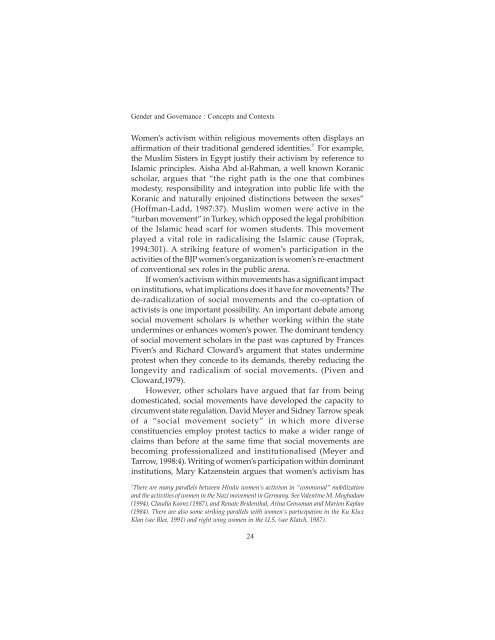Essays On Gender And Governance - United Nations Development ...
Essays On Gender And Governance - United Nations Development ...
Essays On Gender And Governance - United Nations Development ...
You also want an ePaper? Increase the reach of your titles
YUMPU automatically turns print PDFs into web optimized ePapers that Google loves.
<strong>Gender</strong> and <strong>Governance</strong> : Concepts and Contexts<br />
Women’s activism within religious movements often displays an<br />
affirmation of their traditional gendered identities. 7 For example,<br />
the Muslim Sisters in Egypt justify their activism by reference to<br />
Islamic principles. Aisha Abd al-Rahman, a well known Koranic<br />
scholar, argues that “the right path is the one that combines<br />
modesty, responsibility and integration into public life with the<br />
Koranic and naturally enjoined distinctions between the sexes”<br />
(Hoffman-Ladd, 1987:37). Muslim women were active in the<br />
“turban movement” in Turkey, which opposed the legal prohibition<br />
of the Islamic head scarf for women students. This movement<br />
played a vital role in radicalising the Islamic cause (Toprak,<br />
1994:301). A striking feature of women’s participation in the<br />
activities of the BJP women’s organization is women’s re-enactment<br />
of conventional sex roles in the public arena.<br />
If women’s activism within movements has a significant impact<br />
on institutions, what implications does it have for movements? The<br />
de-radicalization of social movements and the co-optation of<br />
activists is one important possibility. An important debate among<br />
social movement scholars is whether working within the state<br />
undermines or enhances women’s power. The dominant tendency<br />
of social movement scholars in the past was captured by Frances<br />
Piven’s and Richard Cloward’s argument that states undermine<br />
protest when they concede to its demands, thereby reducing the<br />
longevity and radicalism of social movements. (Piven and<br />
Cloward,1979).<br />
However, other scholars have argued that far from being<br />
domesticated, social movements have developed the capacity to<br />
circumvent state regulation. David Meyer and Sidney Tarrow speak<br />
of a “social movement society” in which more diverse<br />
constituencies employ protest tactics to make a wider range of<br />
claims than before at the same time that social movements are<br />
becoming professionalized and institutionalised (Meyer and<br />
Tarrow, 1998:4). Writing of women’s participation within dominant<br />
institutions, Mary Katzenstein argues that women’s activism has<br />
7<br />
There are many parallels between Hindu women’s activism in “communal” mobilization<br />
and the activities of women in the Nazi movement in Germany. See Valentine M. Moghadam<br />
(1994), Claudia Koonz (1987), and Renate Bridenthal, Atina Grossman and Marion Kaplan<br />
(1984). There are also some striking parallels with women’s participation in the Ku Klux<br />
Klan (see Blee, 1991) and right wing women in the U.S. (see Klatch, 1987).<br />
24

















